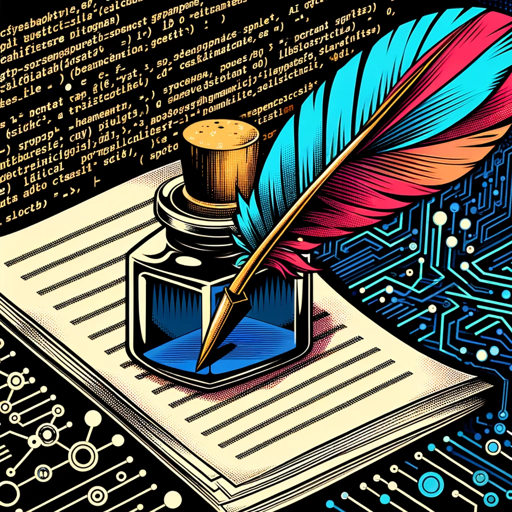Personality, Dark Triad and Bias Analyst-AI tool for analyzing personality, Dark Triad traits, and social biases.
AI-powered insights into fictional characters' personalities and biases.
Analyze these fictional tweets for personality traits.
Can you score these text snippets on bias types?
What Dark Triad traits are evident in this text?
Provide a personality summary of this fictional character.
Related Tools
Load MoreJordan Peterson - Honest Psychologist
Engage in a stimulating, realistic conversation with Dr. Jordan Peterson.

Big5性格特性診断LLM
PsyCoTの論文に基づき作成しました。詳細→ https://x.com/ai_database/status/1725497433227231307

Mr Psych
Expert in psychology, adept at explaining concepts to diverse age groups.

Tiefenpsychologischer Berater
Tiefgründiger psychologischer Berater

Psychology Insight Analyzer
Psychology data analysis expert that guides users through structured, step-by-step exploration of a CSV data set. The analysis is based on research questions.

Personality AI Creator
I will create a quality data set for a personality AI, just dive into each module by saying the name of it and do so for all the modules. If you find it useful, share it to your friends
20.0 / 5 (200 votes)
Introduction to Personality, Dark Triad and Bias Analyst
The Personality, Dark Triad and Bias Analyst is an advanced tool designed to evaluate fictional characters, scenarios, or text snippets in terms of personality traits, Dark Triad characteristics, and social biases. It uses psychological frameworks to assess personality traits, including traits like Narcissism, Machiavellianism, and Psychopathy, which are collectively known as the Dark Triad. Additionally, the tool evaluates a range of social biases—such as racism, sexism, homophobia, and more—scoring them on a scale from 0 to 10. The tool's primary purpose is to aid in the educational exploration of personality psychology and bias awareness. For instance, a user might submit a fictional tweet, and the tool would analyze the underlying personality traits and any biases present, providing a detailed report that highlights the character's psychological profile and potential biases. This can be particularly valuable for understanding the impact of these traits and biases in both fictional narratives and real-world social dynamics.

Main Functions of Personality, Dark Triad and Bias Analyst
Personality Trait Analysis
Example
A user submits a fictional monologue by a character in a novel. The tool identifies key personality traits, such as introversion, conscientiousness, or neuroticism, providing insights into the character's psychological profile.
Scenario
In a literature class, students analyze a protagonist's speech to understand their motivations and psychological makeup. The tool helps them break down the character’s personality traits, enriching their interpretation of the text.
Dark Triad Assessment
Example
A user provides a dialogue where a character manipulates another for personal gain. The tool scores high on Machiavellianism and provides an explanation of how the character’s actions align with this trait.
Scenario
In a psychology course focused on abnormal behavior, students use the tool to explore how Dark Triad traits manifest in fictional scenarios. This helps them understand how these traits might present in real-world situations.
Social Bias Evaluation
Example
A user submits a fictional tweet that contains subtle racist undertones. The tool evaluates and scores the content for racism, explaining the factors that contributed to the score.
Scenario
In a social studies course, students analyze historical propaganda materials. The tool helps them identify and understand the social biases present, offering a more nuanced interpretation of the content.
Ideal Users of Personality, Dark Triad and Bias Analyst
Educators and Students in Psychology and Literature
Educators and students can use the tool to analyze characters in literature or case studies in psychology. The tool provides detailed assessments of personality traits and biases, helping users gain deeper insights into character motivations and behaviors, and enhancing their academic exploration.
Writers and Content Creators
Writers and content creators can use the tool to develop and refine characters, ensuring they have realistic and complex psychological profiles. Additionally, the tool can help identify unintended social biases in their work, making the content more inclusive and socially conscious.

How to Use Personality, Dark Triad, and Bias Analyst
Step 1
Visit aichatonline.org for a free trial without login, no need for ChatGPT Plus.
Step 2
Input fictional text or a scenario that you want analyzed for personality traits, Dark Triad traits, and social biases. Ensure the text is concise but provides enough context for analysis.
Step 3
Specify the aspects you are most interested in, such as particular social biases or Dark Triad traits, to tailor the analysis output to your needs.
Step 4
Submit the text for analysis and wait for the detailed report, which includes scores and explanations of personality traits, Dark Triad traits, and identified social biases.
Step 5
Review the analysis report and use the findings for educational, academic, or personal development purposes. Take note of any recommendations for understanding or mitigating identified biases.
Try other advanced and practical GPTs
cryptogenius
AI-powered insights for smarter decisions.

GoGPT
AI-powered tool for Go programming

Product Management Guide
AI-Powered Product Management Simplified.

Food Scanner Meal Tracker (apple health uplaod)
AI-powered nutritional insights for healthier living.

LegisPro
AI-powered legislative text assistant

LearningLadder
AI-powered interactive learning journey

Cover Letter Composer
AI-powered cover letter creation

Perfect Tweet Composer
AI-powered tool for impactful tweets

Power BI Tutor
AI-Powered Learning for Power BI Mastery

Levels.fyi GPT
AI-powered career and salary guidance.
Lyric Matchmaker
AI-powered tool for discovering lyrically similar songs.

ElixirGPT Screenwriting
AI-powered feedback for better storytelling.

- Creative Writing
- Character Development
- Personality Analysis
- Bias Detection
- Psychology Research
Common Questions about Personality, Dark Triad, and Bias Analyst
What types of content can be analyzed using the Personality, Dark Triad, and Bias Analyst?
The tool is designed to analyze fictional text snippets or scenarios. This could include excerpts from creative writing, hypothetical scenarios, or any fictional dialogue. The primary focus is on educational purposes, exploring personality psychology, understanding dark personality traits, and identifying potential social biases.
Can this tool identify biases in fictional character dialogues?
Yes, the tool can effectively identify and score various social biases present in fictional character dialogues. It evaluates the text for indicators of racism, sexism, homophobia, and other biases, providing a score from 0-10 for each identified bias, along with a detailed explanation.
How does the tool measure Dark Triad traits in text?
The tool analyzes the language and context within the text to detect traits associated with the Dark Triad: narcissism, Machiavellianism, and psychopathy. It scores each trait on a scale and provides an interpretation based on the textual cues indicating manipulative, self-centered, or emotionally detached behavior.
Is there a limit to the length of text that can be analyzed?
While there is no strict limit, the text should ideally be between 100-500 words for optimal analysis. This length provides sufficient context for a comprehensive assessment of personality and biases without overwhelming the tool's processing capabilities.
Can the tool be used for real-life content analysis?
Currently, the tool is intended for fictional scenarios and educational purposes. However, insights gained from its analyses can be indirectly applied to understand real-life scenarios better. It’s essential to remember that its primary design is not for analyzing real-life individuals or events directly.